2012 FORD SUPER DUTY towing
[x] Cancel search: towingPage 3 of 93
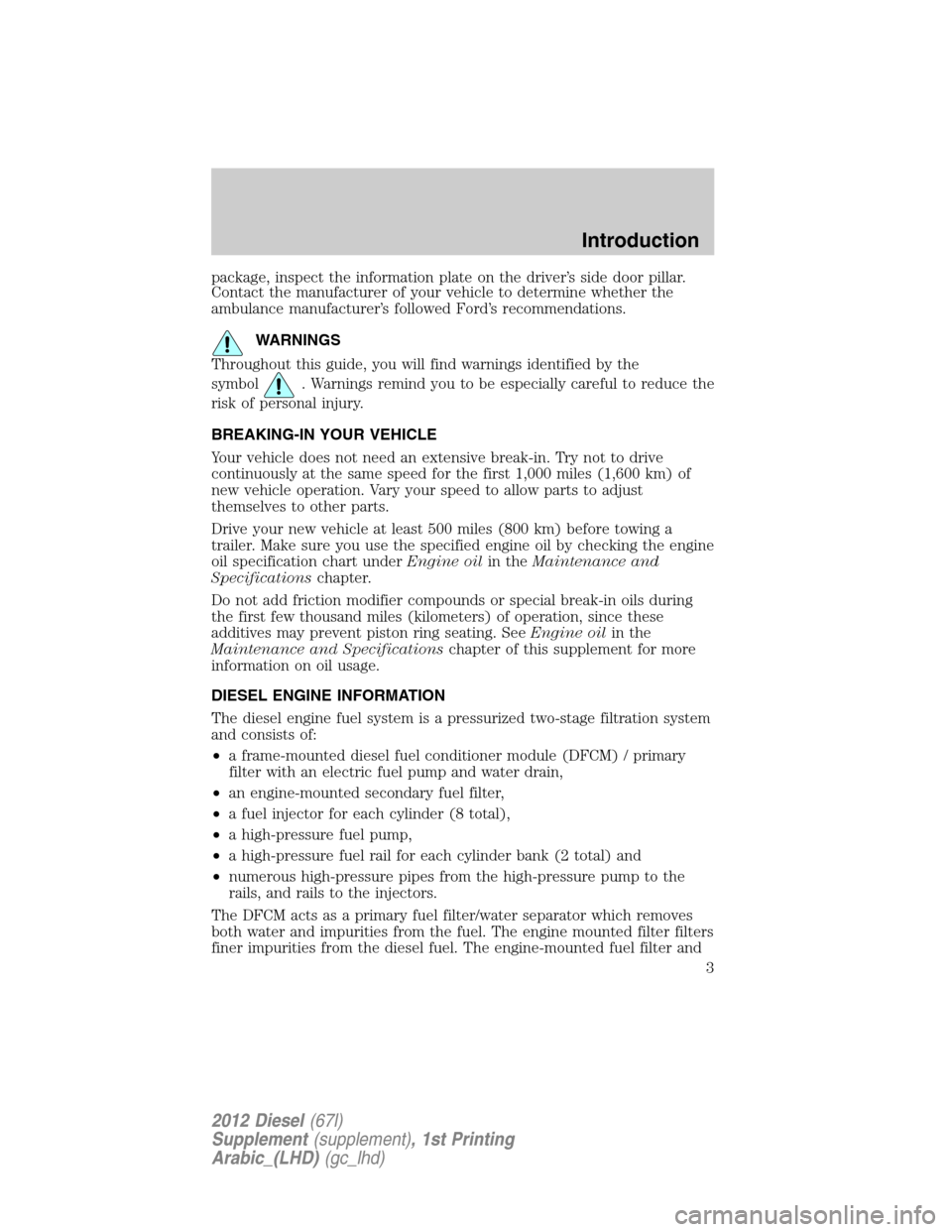
package, inspect the information plate on the driver’s side door pillar.
Contact the manufacturer of your vehicle to determine whether the
ambulance manufacturer’s followed Ford’s recommendations.
WARNINGS
Throughout this guide, you will find warnings identified by the
symbol
. Warnings remind you to be especially careful to reduce the
risk of personal injury.
BREAKING-IN YOUR VEHICLE
Your vehicle does not need an extensive break-in. Try not to drive
continuously at the same speed for the first 1,000 miles (1,600 km) of
new vehicle operation. Vary your speed to allow parts to adjust
themselves to other parts.
Drive your new vehicle at least 500 miles (800 km) before towing a
trailer. Make sure you use the specified engine oil by checking the engine
oil specification chart underEngine oilin theMaintenance and
Specificationschapter.
Do not add friction modifier compounds or special break-in oils during
the first few thousand miles (kilometers) of operation, since these
additives may prevent piston ring seating. SeeEngine oilin the
Maintenance and Specificationschapter of this supplement for more
information on oil usage.
DIESEL ENGINE INFORMATION
The diesel engine fuel system is a pressurized two-stage filtration system
and consists of:
•a frame-mounted diesel fuel conditioner module (DFCM) / primary
filter with an electric fuel pump and water drain,
•an engine-mounted secondary fuel filter,
•a fuel injector for each cylinder (8 total),
•a high-pressure fuel pump,
•a high-pressure fuel rail for each cylinder bank (2 total) and
•numerous high-pressure pipes from the high-pressure pump to the
rails, and rails to the injectors.
The DFCM acts as a primary fuel filter/water separator which removes
both water and impurities from the fuel. The engine mounted filter filters
finer impurities from the diesel fuel. The engine-mounted fuel filter and
Introduction
3
2012 Diesel(67l)
Supplement(supplement), 1st Printing
Arabic_(LHD)(gc_lhd)
Page 8 of 93
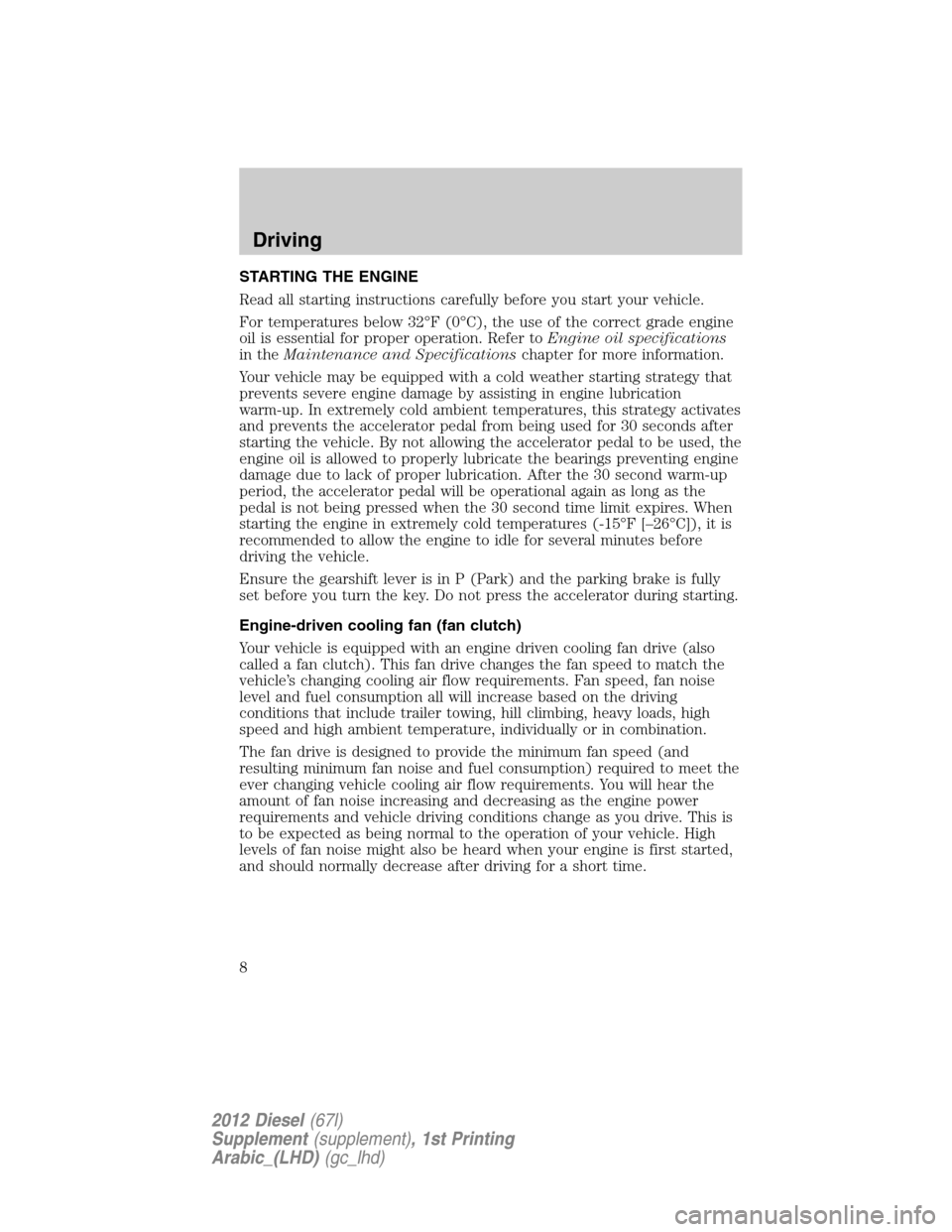
STARTING THE ENGINE
Read all starting instructions carefully before you start your vehicle.
For temperatures below 32°F (0°C), the use of the correct grade engine
oil is essential for proper operation. Refer toEngine oil specifications
in theMaintenance and Specificationschapter for more information.
Your vehicle may be equipped with a cold weather starting strategy that
prevents severe engine damage by assisting in engine lubrication
warm-up. In extremely cold ambient temperatures, this strategy activates
and prevents the accelerator pedal from being used for 30 seconds after
starting the vehicle. By not allowing the accelerator pedal to be used, the
engine oil is allowed to properly lubricate the bearings preventing engine
damage due to lack of proper lubrication. After the 30 second warm-up
period, the accelerator pedal will be operational again as long as the
pedal is not being pressed when the 30 second time limit expires. When
starting the engine in extremely cold temperatures (-15°F [–26°C]), it is
recommended to allow the engine to idle for several minutes before
driving the vehicle.
Ensure the gearshift lever is in P (Park) and the parking brake is fully
set before you turn the key. Do not press the accelerator during starting.
Engine-driven cooling fan (fan clutch)
Your vehicle is equipped with an engine driven cooling fan drive (also
called a fan clutch). This fan drive changes the fan speed to match the
vehicle’s changing cooling air flow requirements. Fan speed, fan noise
level and fuel consumption all will increase based on the driving
conditions that include trailer towing, hill climbing, heavy loads, high
speed and high ambient temperature, individually or in combination.
The fan drive is designed to provide the minimum fan speed (and
resulting minimum fan noise and fuel consumption) required to meet the
ever changing vehicle cooling air flow requirements. You will hear the
amount of fan noise increasing and decreasing as the engine power
requirements and vehicle driving conditions change as you drive. This is
to be expected as being normal to the operation of your vehicle. High
levels of fan noise might also be heard when your engine is first started,
and should normally decrease after driving for a short time.
Driving
8
2012 Diesel(67l)
Supplement(supplement), 1st Printing
Arabic_(LHD)(gc_lhd)
Page 15 of 93
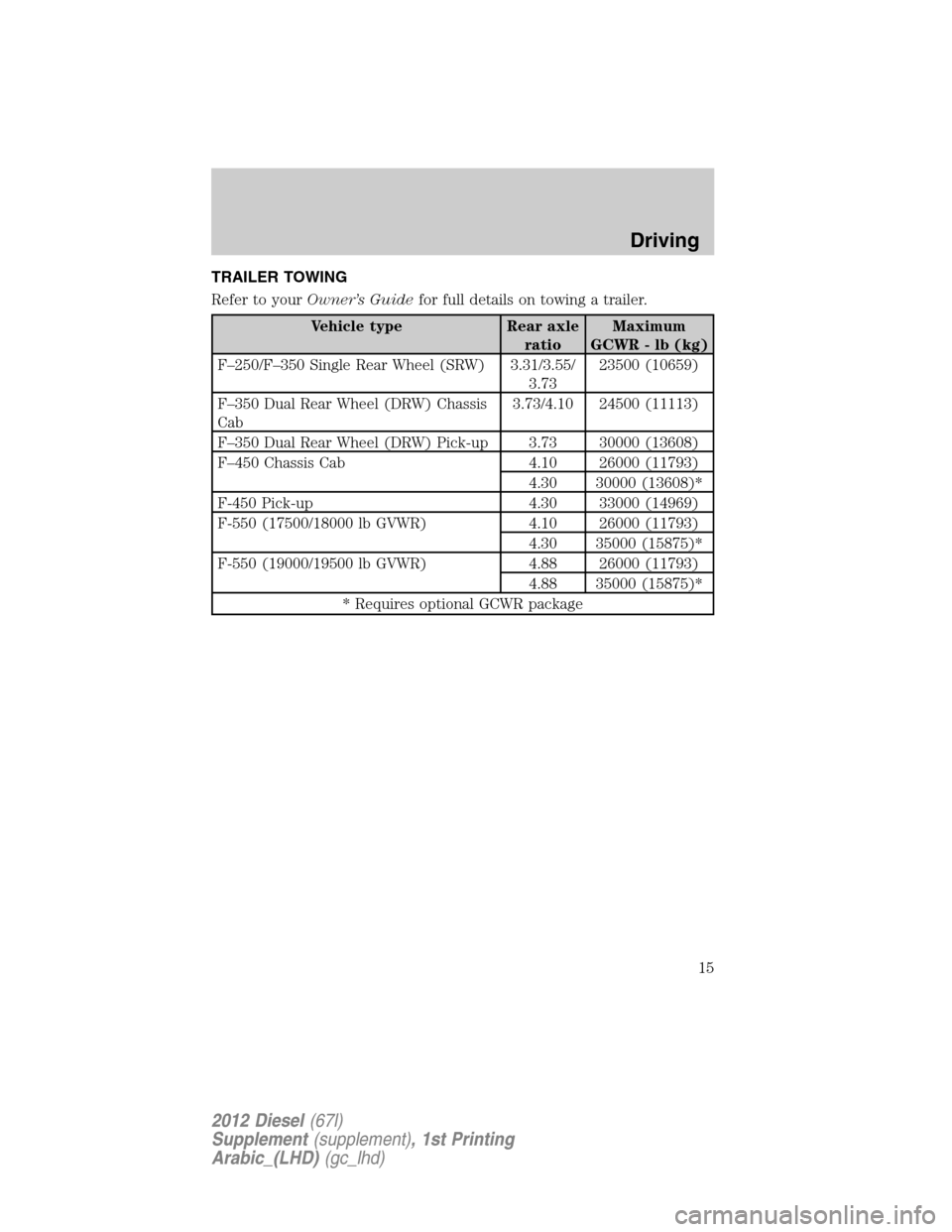
TRAILER TOWING
Refer to yourOwner’s Guidefor full details on towing a trailer.
Vehicle type Rear axle
ratioMaximum
GCWR - lb (kg)
F–250/F–350 Single Rear Wheel (SRW) 3.31/3.55/
3.7323500 (10659)
F–350 Dual Rear Wheel (DRW) Chassis
Cab3.73/4.10 24500 (11113)
F–350 Dual Rear Wheel (DRW) Pick-up 3.73 30000 (13608)
F–450 Chassis Cab 4.10 26000 (11793)
4.30 30000 (13608)*
F-450 Pick-up 4.30 33000 (14969)
F-550 (17500/18000 lb GVWR) 4.10 26000 (11793)
4.30 35000 (15875)*
F-550 (19000/19500 lb GVWR) 4.88 26000 (11793)
4.88 35000 (15875)*
* Requires optional GCWR package
Driving
15
2012 Diesel(67l)
Supplement(supplement), 1st Printing
Arabic_(LHD)(gc_lhd)
Page 26 of 93
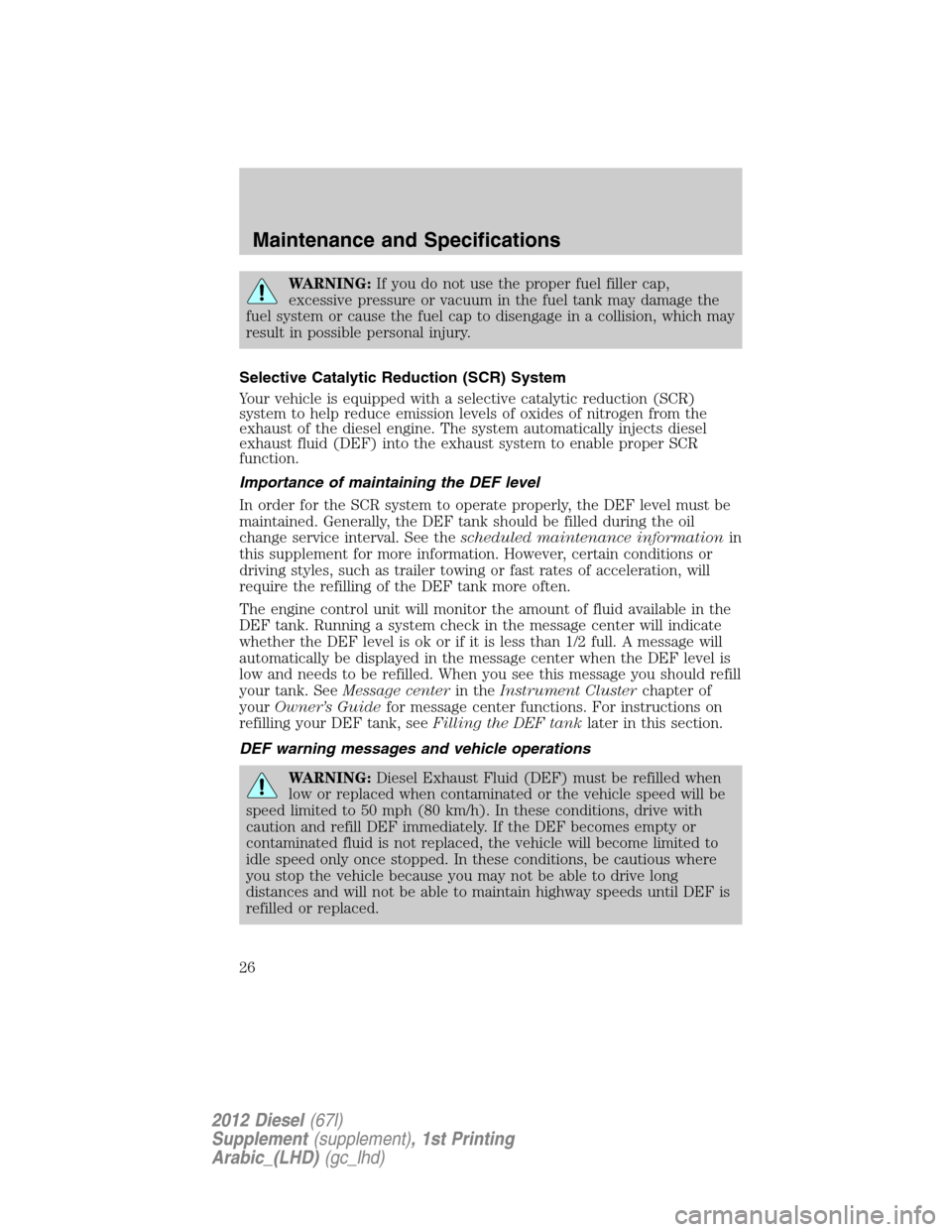
WARNING:If you do not use the proper fuel filler cap,
excessive pressure or vacuum in the fuel tank may damage the
fuel system or cause the fuel cap to disengage in a collision, which may
result in possible personal injury.
Selective Catalytic Reduction (SCR) System
Your vehicle is equipped with a selective catalytic reduction (SCR)
system to help reduce emission levels of oxides of nitrogen from the
exhaust of the diesel engine. The system automatically injects diesel
exhaust fluid (DEF) into the exhaust system to enable proper SCR
function.
Importance of maintaining the DEF level
In order for the SCR system to operate properly, the DEF level must be
maintained. Generally, the DEF tank should be filled during the oil
change service interval. See thescheduled maintenance informationin
this supplement for more information. However, certain conditions or
driving styles, such as trailer towing or fast rates of acceleration, will
require the refilling of the DEF tank more often.
The engine control unit will monitor the amount of fluid available in the
DEF tank. Running a system check in the message center will indicate
whether the DEF level is ok or if it is less than 1/2 full. A message will
automatically be displayed in the message center when the DEF level is
low and needs to be refilled. When you see this message you should refill
your tank. SeeMessage centerin theInstrument Clusterchapter of
yourOwner’s Guidefor message center functions. For instructions on
refilling your DEF tank, seeFilling the DEF tanklater in this section.
DEF warning messages and vehicle operations
WARNING:Diesel Exhaust Fluid (DEF) must be refilled when
low or replaced when contaminated or the vehicle speed will be
speed limited to 50 mph (80 km/h). In these conditions, drive with
caution and refill DEF immediately. If the DEF becomes empty or
contaminated fluid is not replaced, the vehicle will become limited to
idle speed only once stopped. In these conditions, be cautious where
you stop the vehicle because you may not be able to drive long
distances and will not be able to maintain highway speeds until DEF is
refilled or replaced.
Maintenance and Specifications
26
2012 Diesel(67l)
Supplement(supplement), 1st Printing
Arabic_(LHD)(gc_lhd)
Page 35 of 93
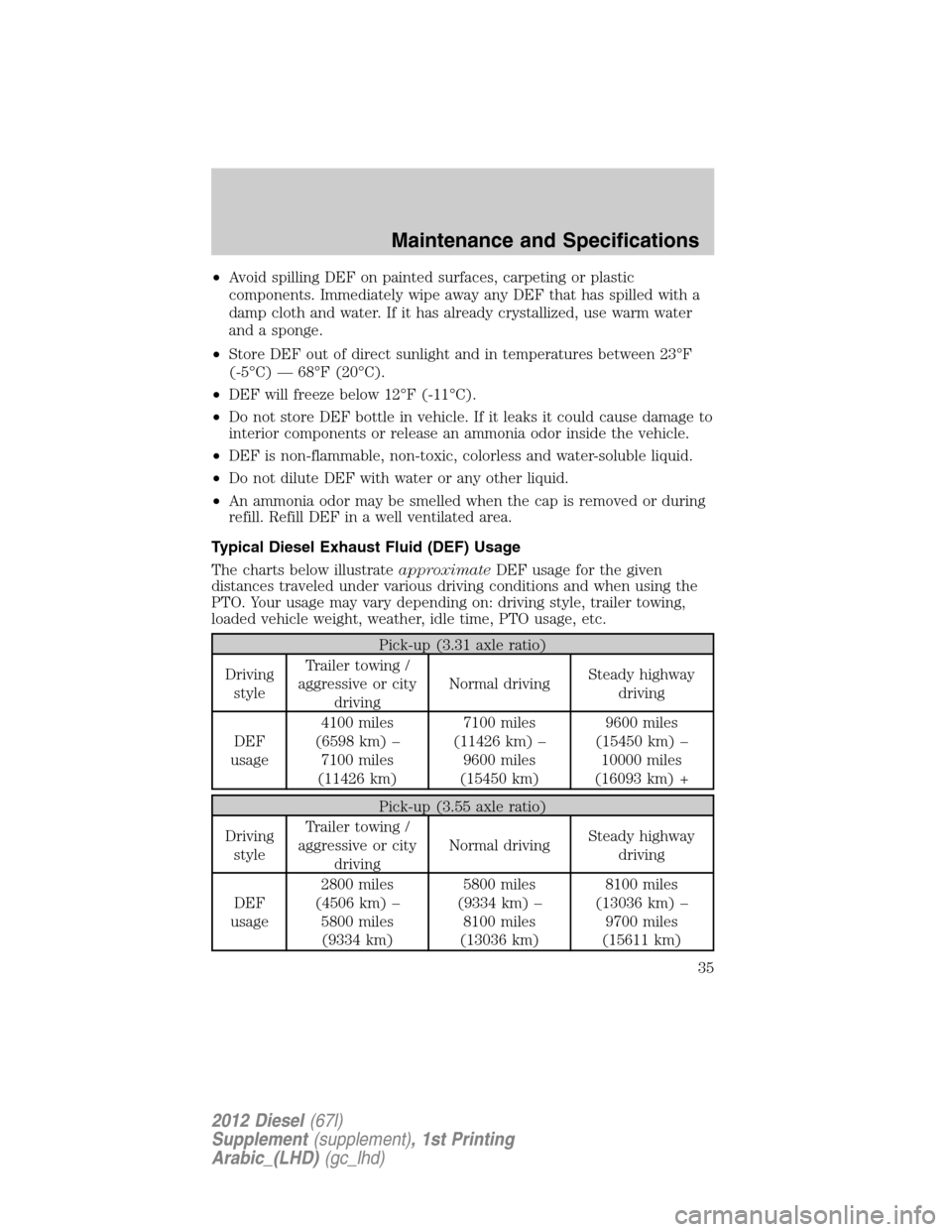
•Avoid spilling DEF on painted surfaces, carpeting or plastic
components. Immediately wipe away any DEF that has spilled with a
damp cloth and water. If it has already crystallized, use warm water
and a sponge.
•Store DEF out of direct sunlight and in temperatures between 23°F
(-5°C) — 68°F (20°C).
•DEF will freeze below 12°F (-11°C).
•Do not store DEF bottle in vehicle. If it leaks it could cause damage to
interior components or release an ammonia odor inside the vehicle.
•DEF is non-flammable, non-toxic, colorless and water-soluble liquid.
•Do not dilute DEF with water or any other liquid.
•An ammonia odor may be smelled when the cap is removed or during
refill. Refill DEF in a well ventilated area.
Typical Diesel Exhaust Fluid (DEF) Usage
The charts below illustrateapproximateDEF usage for the given
distances traveled under various driving conditions and when using the
PTO. Your usage may vary depending on: driving style, trailer towing,
loaded vehicle weight, weather, idle time, PTO usage, etc.
Pick-up (3.31 axle ratio)
Driving
styleTrailer towing /
aggressive or city
drivingNormal drivingSteady highway
driving
DEF
usage4100 miles
(6598 km) –
7100 miles
(11426 km)7100 miles
(11426 km) –
9600 miles
(15450 km)9600 miles
(15450 km) –
10000 miles
(16093 km) +
Pick-up (3.55 axle ratio)
Driving
styleTrailer towing /
aggressive or city
drivingNormal drivingSteady highway
driving
DEF
usage2800 miles
(4506 km) –
5800 miles
(9334 km)5800 miles
(9334 km) –
8100 miles
(13036 km)8100 miles
(13036 km) –
9700 miles
(15611 km)
Maintenance and Specifications
35
2012 Diesel(67l)
Supplement(supplement), 1st Printing
Arabic_(LHD)(gc_lhd)
Page 36 of 93
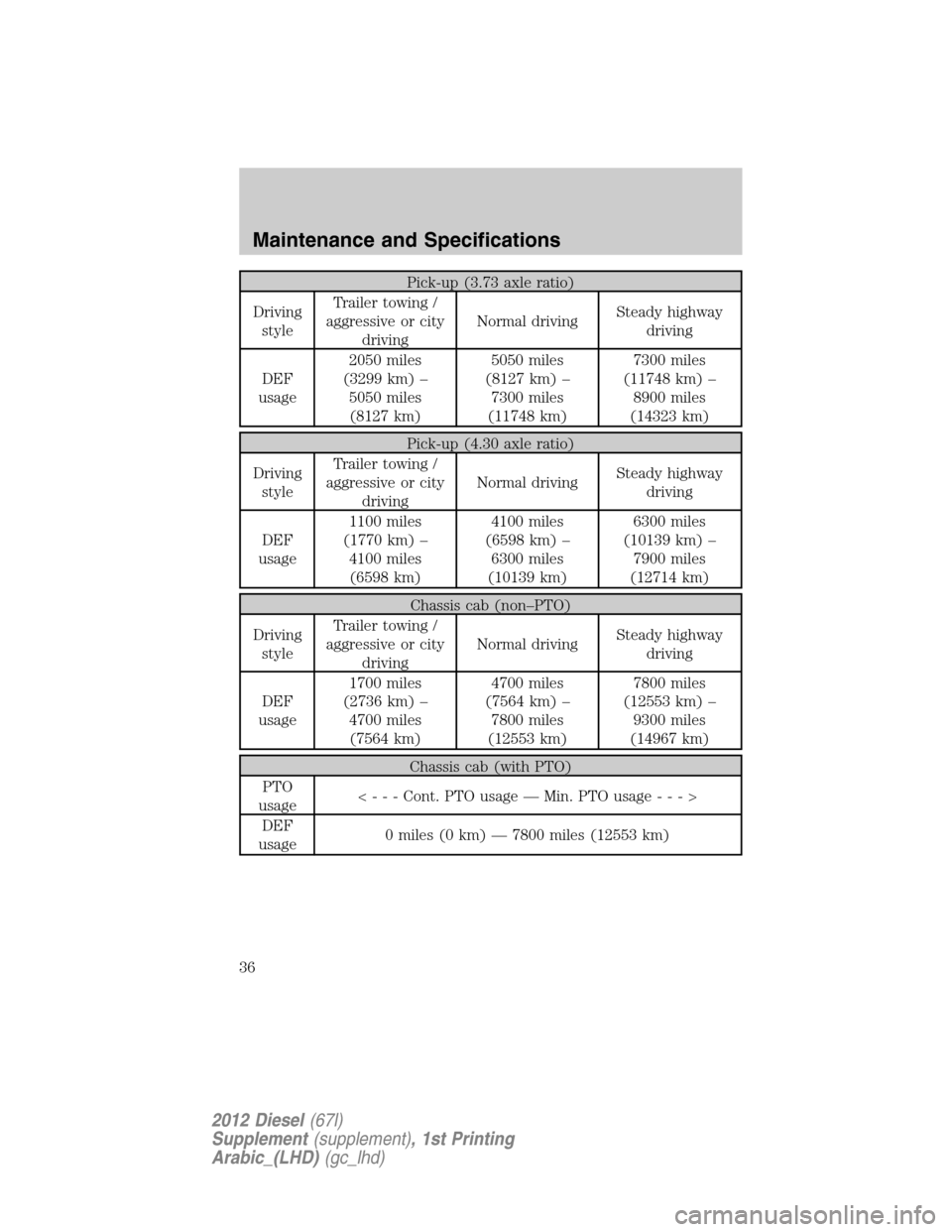
Pick-up (3.73 axle ratio)
Driving
styleTrailer towing /
aggressive or city
drivingNormal drivingSteady highway
driving
DEF
usage2050 miles
(3299 km) –
5050 miles
(8127 km)5050 miles
(8127 km) –
7300 miles
(11748 km)7300 miles
(11748 km) –
8900 miles
(14323 km)
Pick-up (4.30 axle ratio)
Driving
styleTrailer towing /
aggressive or city
drivingNormal drivingSteady highway
driving
DEF
usage1100 miles
(1770 km) –
4100 miles
(6598 km)4100 miles
(6598 km) –
6300 miles
(10139 km)6300 miles
(10139 km) –
7900 miles
(12714 km)
Chassis cab (non–PTO)
Driving
styleTrailer towing /
aggressive or city
drivingNormal drivingSteady highway
driving
DEF
usage1700 miles
(2736 km) –
4700 miles
(7564 km)4700 miles
(7564 km) –
7800 miles
(12553 km)7800 miles
(12553 km) –
9300 miles
(14967 km)
Chassis cab (with PTO)
PTO
usage<---Cont. PTO usage — Min. PTO usage--->
DEF
usage0 miles (0 km) — 7800 miles (12553 km)
Maintenance and Specifications
36
2012 Diesel(67l)
Supplement(supplement), 1st Printing
Arabic_(LHD)(gc_lhd)
Page 44 of 93
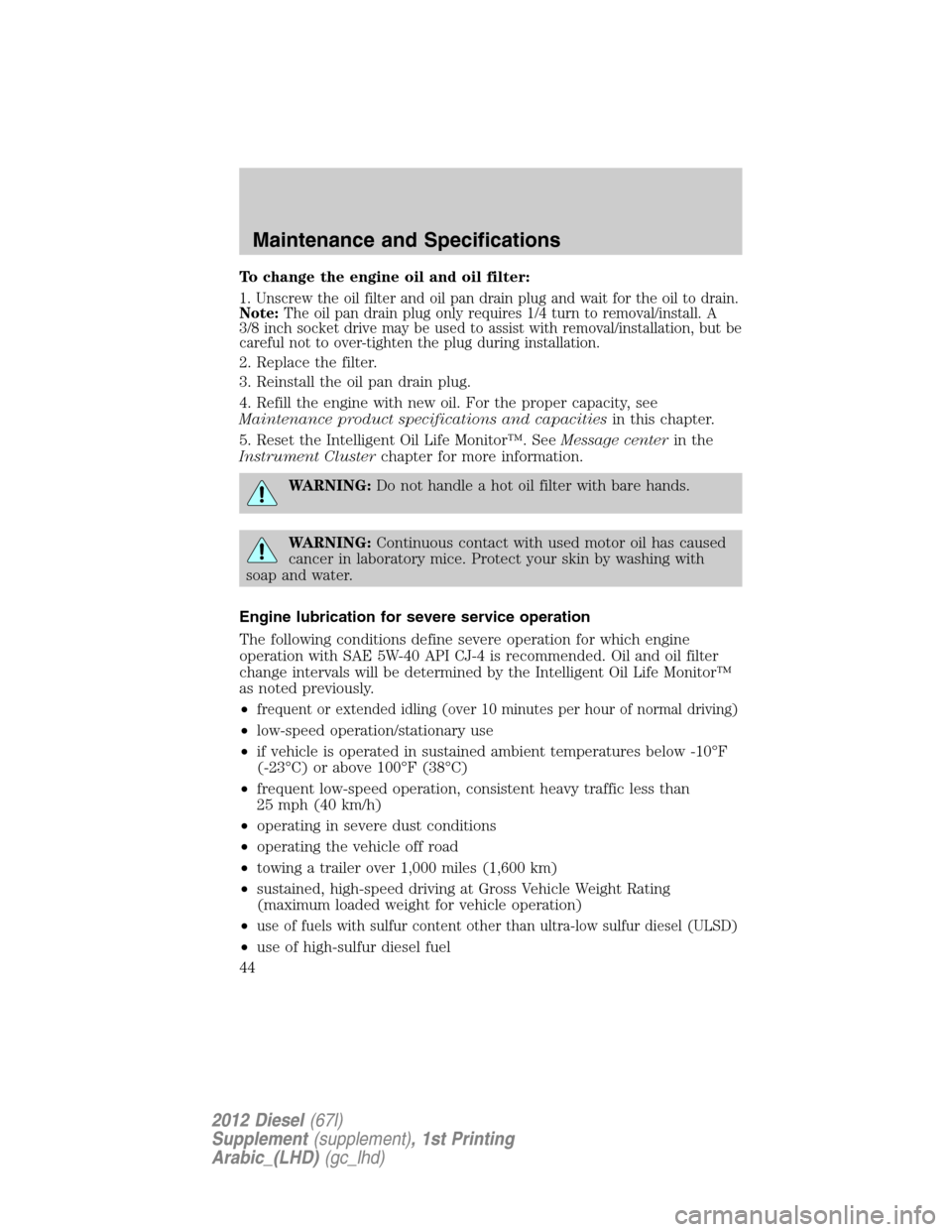
To change the engine oil and oil filter:
1. Unscrew the oil filter and oil pan drain plug and wait for the oil to drain.
Note:The oil pan drain plug only requires 1/4 turn to removal/install. A
3/8 inch socket drive may be used to assist with removal/installation, but be
careful not to over-tighten the plug during installation.
2. Replace the filter.
3. Reinstall the oil pan drain plug.
4. Refill the engine with new oil. For the proper capacity, see
Maintenance product specifications and capacitiesin this chapter.
5. Reset the Intelligent Oil Life Monitor™. SeeMessage centerin the
Instrument Clusterchapter for more information.
WARNING:Do not handle a hot oil filter with bare hands.
WARNING:Continuous contact with used motor oil has caused
cancer in laboratory mice. Protect your skin by washing with
soap and water.
Engine lubrication for severe service operation
The following conditions define severe operation for which engine
operation with SAE 5W-40 API CJ-4 is recommended. Oil and oil filter
change intervals will be determined by the Intelligent Oil Life Monitor™
as noted previously.
•
frequent or extended idling (over 10 minutes per hour of normal driving)
•low-speed operation/stationary use
•if vehicle is operated in sustained ambient temperatures below -10°F
(-23°C) or above 100°F (38°C)
•frequent low-speed operation, consistent heavy traffic less than
25 mph (40 km/h)
•operating in severe dust conditions
•operating the vehicle off road
•towing a trailer over 1,000 miles (1,600 km)
•sustained, high-speed driving at Gross Vehicle Weight Rating
(maximum loaded weight for vehicle operation)
•
use of fuels with sulfur content other than ultra-low sulfur diesel (ULSD)
•use of high-sulfur diesel fuel
Maintenance and Specifications
44
2012 Diesel(67l)
Supplement(supplement), 1st Printing
Arabic_(LHD)(gc_lhd)
Page 73 of 93
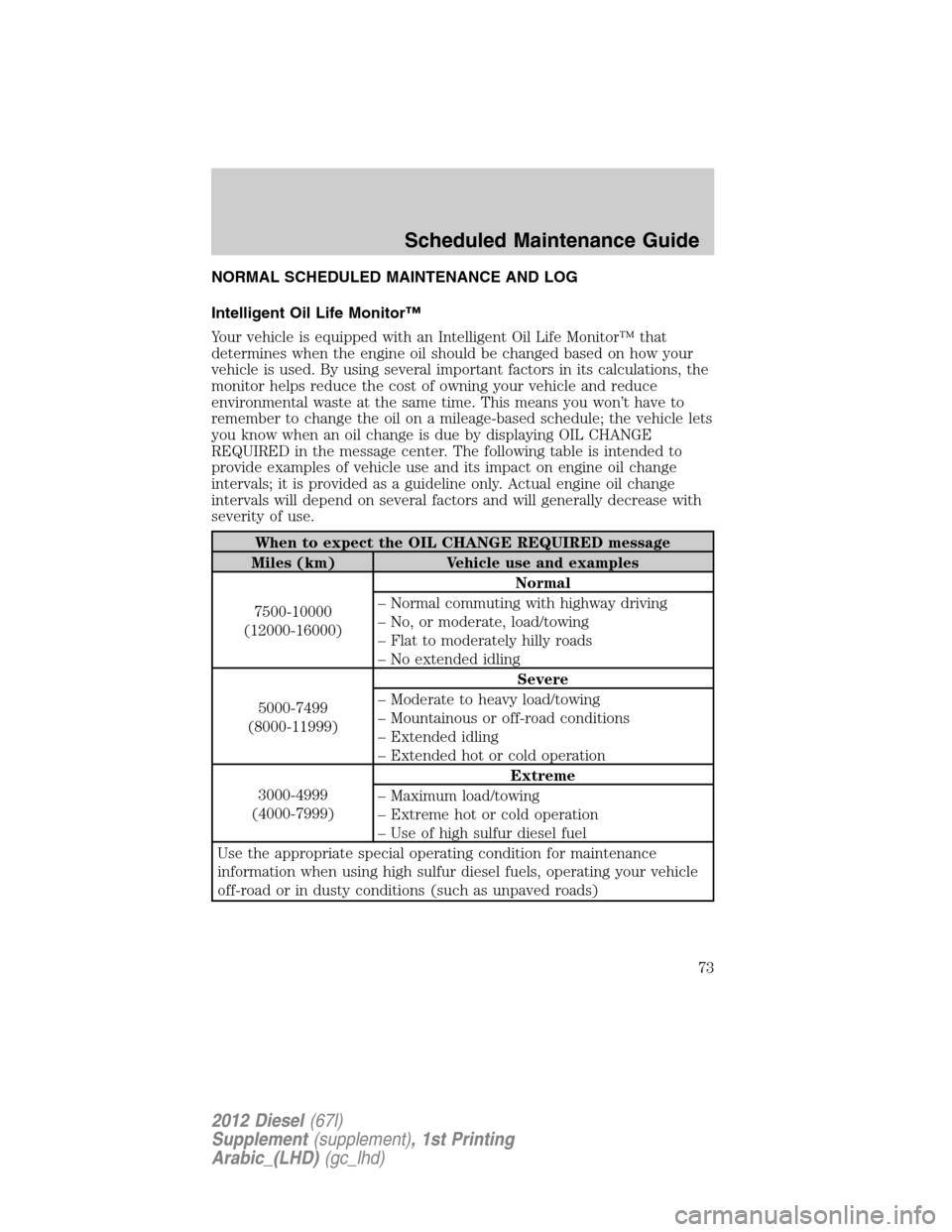
NORMAL SCHEDULED MAINTENANCE AND LOG
Intelligent Oil Life Monitor™
Your vehicle is equipped with an Intelligent Oil Life Monitor™ that
determines when the engine oil should be changed based on how your
vehicle is used. By using several important factors in its calculations, the
monitor helps reduce the cost of owning your vehicle and reduce
environmental waste at the same time. This means you won’t have to
remember to change the oil on a mileage-based schedule; the vehicle lets
you know when an oil change is due by displaying OIL CHANGE
REQUIRED in the message center. The following table is intended to
provide examples of vehicle use and its impact on engine oil change
intervals; it is provided as a guideline only. Actual engine oil change
intervals will depend on several factors and will generally decrease with
severity of use.
When to expect the OIL CHANGE REQUIRED message
Miles (km) Vehicle use and examples
7500-10000
(12000-16000)Normal
– Normal commuting with highway driving
– No, or moderate, load/towing
– Flat to moderately hilly roads
– No extended idling
5000-7499
(8000-11999)Severe
– Moderate to heavy load/towing
– Mountainous or off-road conditions
– Extended idling
– Extended hot or cold operation
3000-4999
(4000-7999)Extreme
– Maximum load/towing
– Extreme hot or cold operation
– Use of high sulfur diesel fuel
Use the appropriate special operating condition for maintenance
information when using high sulfur diesel fuels, operating your vehicle
off-road or in dusty conditions (such as unpaved roads)
Scheduled Maintenance Guide
73
2012 Diesel(67l)
Supplement(supplement), 1st Printing
Arabic_(LHD)(gc_lhd)